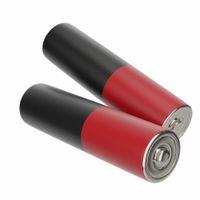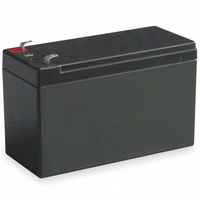Call +(254) 703 030 000 / 751 483 999 / 721 704 777
- Home
- Electronics Batteries
- Batteries Battery Chargers
.....Read More
Frequently Asked Questions
What are the different types of batteries and their uses?
Batteries convert chemical energy into electrical energy, and different types are suited for various applications.
**Primary (Non-Rechargeable) Batteries:** * **Alkaline Batteries:** Common for everyday devices like remote controls and flashlights. They offer good energy density and shelf life.
* **Lithium Batteries (Primary):** Provide high energy density and long life, ideal for critical applications like pacemakers, cameras, and some remote sensors. They perform well in extreme temperatures.**Secondary (Rechargeable) Batteries:** * **Lead-Acid Batteries:** Known for robustness and cost-effectiveness, they are primarily used in vehicles (starting, lighting, ignition - SLI), uninterruptible power supplies (UPS), and off-grid energy storage.
* **Nickel-Cadmium (NiCd) Batteries:** Older technology, still used in some power tools and medical equipment due to their durability and ability to deliver high current. They suffer from the "memory effect."
* **Nickel-Metal Hydride (NiMH) Batteries:** An improvement over NiCd, offering higher energy density and less memory effect. Used in hybrid electric vehicles, digital cameras, and portable electronics.
* **Lithium-Ion (Li-ion) Batteries:** Dominant in portable electronics (smartphones, laptops), electric vehicles, and grid-scale energy storage due to their high energy density, lightweight nature, and no memory effect.
* **Lithium-Polymer (Li-Po) Batteries:** Similar to Li-ion but use a polymer electrolyte, allowing for flexible and thinner designs, common in drones and wearable devices.Each battery type has specific characteristics regarding energy density, power output, cycle life, safety, and cost, dictating its suitability for different applications.
How do rechargeable batteries work?
Rechargeable batteries, unlike single-use batteries, can be recharged and reused multiple times. This is made possible by reversible chemical reactions. During discharge, chemical energy is converted into electrical energy as ions move from the anode to the cathode through an electrolyte, and electrons flow through an external circuit. When charging, an external electrical current forces the ions to move back from the cathode to the anode, reversing the chemical reaction and storing energy. The most common type, lithium-ion batteries, use lithium ions for this process, offering high energy density and a long cycle life. Over time, the materials within a rechargeable battery degrade, leading to a decrease in capacity and eventually, the battery's end of life.
How long do rechargeable batteries last?
The lifespan of rechargeable batteries, such as NiMH (Nickel-Metal Hydride) or Li-ion (Lithium-ion), varies depending on several factors including the battery chemistry, usage patterns, charging habits, and environmental conditions.
Generally, NiMH batteries can last for 500 to 1,000 charge cycles. This means they can be fully discharged and recharged hundreds of times before their capacity significantly diminishes. Factors like deep discharging, rapid charging, and extreme temperatures can reduce this lifespan.
Li-ion batteries typically offer a longer lifespan, often ranging from 300 to 500 full charge cycles, or even more in some cases. However, their degradation is also influenced by temperature and the depth of discharge. It's often recommended to avoid fully discharging Li-ion batteries and to store them at a partial charge (around 50%) if not used for extended periods.
For both types, proper care, such as avoiding extreme temperatures and using appropriate chargers, can help extend their useful life. Over time, all rechargeable batteries experience a decline in capacity, meaning they hold less charge than when new.
What is the best way to store batteries?
To store batteries effectively and prolong their lifespan, consider the following:
**Temperature:** Store batteries in a cool, dry place. Extreme temperatures, both hot and cold, can degrade battery performance and capacity. Avoid direct sunlight and unheated garages or attics. A temperature between 15°C and 25°C (59°F and 77°F) is generally ideal.
**Humidity:** High humidity can cause corrosion. Ensure the storage area is dry and well-ventilated.
**Original Packaging:** If possible, keep batteries in their original packaging until ready for use. This protects them from short circuits, dust, and moisture.
**Separation:** If you don't have original packaging, store batteries individually to prevent them from touching and potentially short-circuiting, which can lead to heat generation or even fire. You can use battery organizers or small plastic bags for this purpose.
**Orientation:** Store alkaline batteries with both terminals facing the same direction to prevent accidental contact. For lithium-ion batteries, ensure they are stored at a partial charge (around 50%) rather than fully charged or fully depleted.
**Avoid Metal Objects:** Do not store batteries with loose metal objects like coins, keys, or paper clips, as these can create a short circuit.
**Battery Type:** Different battery chemistries (e.g., alkaline, lithium-ion, NiMH) have slightly different storage recommendations. For example, rechargeable batteries may benefit from being stored with a partial charge, as noted for lithium-ion.
By following these guidelines, you can help maintain the performance and safety of your batteries over time.
How do you properly dispose of batteries?
Properly disposing of batteries is crucial for environmental safety and resource recovery. Batteries contain various chemicals and heavy metals, such as lead, mercury, cadmium, and lithium, which can leach into the soil and water if not handled correctly, posing significant environmental and health risks.
To properly dispose of batteries, follow these guidelines:1. **Do not throw them in the regular trash:** This is the most important rule. Batteries should never be put in household waste or recycling bins, as they can cause fires in waste facilities and contaminate other recyclable materials.
2. **Recycle them at designated collection points:** Many retail stores (e.g., electronics stores, hardware stores, supermarkets), municipal recycling centers, and waste management facilities offer battery recycling programs. These programs ensure that batteries are processed to recover valuable materials and neutralize harmful components.
3. **Separate battery types:** Different types of batteries (e.g., alkaline, lithium-ion, nickel-cadmium, lead-acid) often require different recycling processes. Check with your local recycling center or collection point for specific instructions on how to separate them.
4. **Tape the terminals of certain batteries:** For lithium-ion, button cell, and rechargeable batteries, it's a good practice to tape the positive and negative terminals with clear tape to prevent short circuits and potential fires during storage and transportation.
5. **Check for local hazardous waste events:** Some communities host special hazardous waste collection events where you can drop off batteries and other hazardous household items.By following these steps, you contribute to a safer environment, conserve natural resources, and prevent pollution.
What is the difference between alkaline and lithium batteries?
Alkaline and lithium batteries are both common types of batteries, but they differ significantly in their chemical composition, performance characteristics, and ideal uses.
Alkaline batteries, such as the widely used AA and AAA types, derive their power from a reaction between zinc and manganese dioxide, with an alkaline electrolyte. They are generally inexpensive and readily available, offering a good balance of power and lifespan for many everyday devices like remote controls, clocks, and low-drain toys. However, their voltage gradually drops as they discharge, and they perform less efficiently in extreme temperatures.
Lithium batteries, on the other hand, use lithium as the anode material. There are various chemistries, but a common type for consumer use is lithium-ion, found in smartphones and laptops. For disposable batteries, lithium iron disulfide is often used (e.g., Energizer Ultimate Lithium). Lithium batteries boast a higher energy density, meaning they can store more power in a smaller and lighter package. They also maintain a more stable voltage throughout their discharge cycle and perform exceptionally well in extreme temperatures, both hot and cold. These characteristics make them ideal for high-drain devices like digital cameras, GPS units, and certain medical devices, as well as for applications requiring long shelf life. While typically more expensive than alkaline batteries, their superior performance and longevity in specific applications can often justify the higher cost.
How do you choose the right battery charger?
Choosing the right battery charger depends on several factors, primarily the type of battery you're charging and its capacity. Different battery chemistries (e.g., lead-acid, lithium-ion, NiMH) require specific charging protocols to ensure safety and longevity. For instance, lithium-ion batteries need precise voltage and current control to prevent overcharging, while lead-acid batteries often benefit from multi-stage charging.
First, identify the battery type. Check the battery label for its chemistry (e.g., LiFePO4, SLA, AA NiMH) and nominal voltage (e.g., 12V, 3.7V, 1.2V).
Second, consider the battery's capacity, typically measured in amp-hours (Ah) or milliamp-hours (mAh). The charger's output current should be appropriate for the battery's capacity. A general guideline is to choose a charger with an output current that is 10-20% of the battery's capacity. For example, a 100Ah battery could use a 10-20A charger. Charging too quickly can damage the battery, while charging too slowly can be inefficient.
Third, look for safety features. Good chargers include protections against overcharging, short-circuiting, reverse polarity, and overheating. Some advanced chargers also offer desulfation or reconditioning modes for certain battery types.
Finally, consider the charger's compatibility with your power source (AC wall outlet, car 12V, solar panel) and the number of batteries you need to charge simultaneously. If you have multiple batteries of the same type, a multi-bank charger can be convenient.
Can you overcharge a rechargeable battery?
Yes, you can overcharge a rechargeable battery, but the effects vary depending on the battery chemistry.
For lithium-ion (Li-ion) batteries, overcharging can be dangerous. It can lead to overheating, swelling, and in extreme cases, fire or explosion. Most modern devices with Li-ion batteries have built-in protection circuits to prevent overcharging.
Nickel-cadmium (Ni-Cd) and nickel-metal hydride (Ni-MH) batteries are more tolerant of overcharging but it can still reduce their lifespan and capacity. Continuous overcharging can lead to heat generation and electrolyte breakdown. Chargers for these battery types often use a "trickle charge" after reaching full capacity to maintain charge without significant damage.
Regardless of the battery type, it's generally best to avoid overcharging to maximize battery life and ensure safety.
How do you extend the life of a battery?
To extend the life of a battery, avoid extreme temperatures, as both excessive heat and cold can degrade battery performance. Maintain a partial charge rather than fully charging or discharging the battery frequently; for many modern batteries, keeping the charge between 20% and 80% is optimal. When storing a device for an extended period, ensure the battery has a partial charge (around 50%) rather than being fully charged or completely drained. Use the charger specifically designed for your device or a high-quality, compatible alternative. Avoid fast charging unless necessary, as it can generate more heat and stress the battery. If possible, enable battery optimization features on your device that learn usage patterns and manage charging cycles. Finally, limit intensive applications and background processes that drain the battery quickly, as this leads to more frequent charging cycles.
What are the signs of a failing battery?
Signs of a failing car battery include slow engine cranking, dim headlights, or the need for frequent jump starts. The "check engine" light might illuminate, and you might notice a rotten egg smell, which indicates a leaking battery. Additionally, corrosion on the battery terminals or a swollen battery case are physical indicators of a battery nearing the end of its life. Extreme temperatures, frequent short trips, and leaving lights on can all contribute to battery degradation. Regular maintenance, such as checking the battery's voltage and cleaning its terminals, can help prolong its lifespan.





